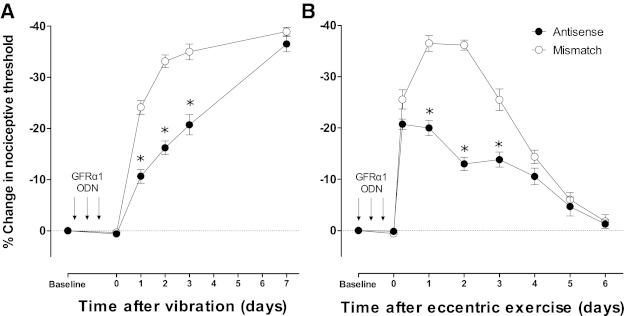Fig. 4.

Intrathecal antisense to GFRα1 inhibits ergonomic insult-induced mechanical hyperalgesia. Rats received a daily intrathecal treatment of antisense (●) or mismatch (○) oligodeoxynucleotide (ODNs) to GFRα1 [40 μg, antisense (AS) or mismatch (MM)] during three consecutive days. They were then submitted to a hindlimb vibration (n = 9/ODN treatment) or eccentric exercise (n = 6/ODN treatment). A: preventive AS, but not MM, treatment inhibited mechanical hyperalgesia after hindlimb vibration on days 1 (AS: 2,376.7 ± 36.3 mN vs. MM: 2,025.1 ± 35.3 mN, P < 0.05), 2 (AS: 2,228.8 ± 37 mN vs. MM: 1,784.9 ± 33.1 mN, P < 0.05), and 3 (AS: 2,108.9 ± 55.7 mN vs. MM: 1,735.3 ± 41.3 mN, P < 0.05) after ergonomic insult. B: preventive AS, but not MM, treatment inhibited mechanical hyperalgesia after hid limb eccentric exercise on days 1 (AS: 2,132.7 ± 0.16 mN vs. MM: 1,680.8 ± 41.8 mN vs. P < 0.05), 2 (AS: 2,319.5 ± 337.5 mN vs. MM: 1,689.7 ± 0.16 mN, P < 0.05), and 3 (AS: 2,296.7 ± 39.2 mN vs. MM: 1,970.8 ± 53.8 mN, P < 0.05) after ergonomic insult. Comparisons to baseline were made using two-way repeated measures ANOVA (time and ODN treatment) followed by Tukey's multiple comparisons test. *P < 0.05.
